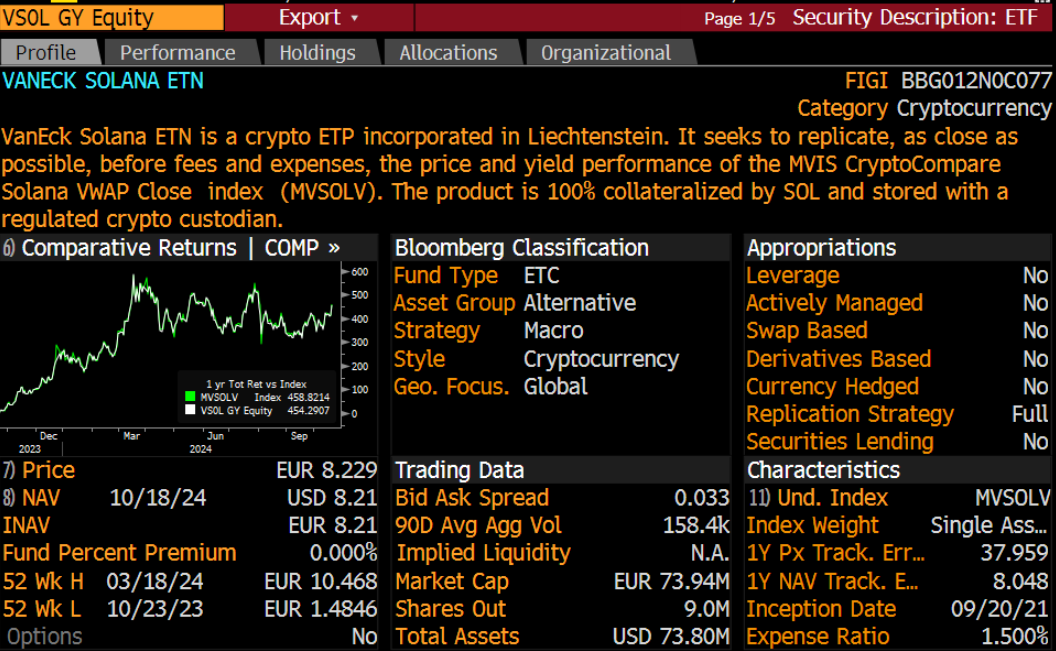
In the global digital asset landscape, regulatory compliance is rapidly becoming a key topic that every Web3 company must face. VanEck is a leading global asset management company headquartered in the United States. It was founded in 1955 and is known for providing innovative investment solutions. VanEck's investment products cover multiple categories such as stocks, fixed income, commodities and alternative investments. In recent years, it has focused on digital assets and blockchain technology. According to Aiying, the scale of cryptocurrency ETPs in Europe has reached 2 billion euros, but the participation of institutional investors is low, and the main investors are individual investors. Many wealth management companies have not made relevant configurations.
VanEck's goal is to allow investors to easily access these asset classes full of opportunities by developing emerging markets and new financial instruments. Currently, VanEck has launched 12 token-based cryptocurrency ETPs in the European market. These ETPs include Bitcoin and Ethereum ETNs (Exchange Traded Notes) and the recently launched Solana Exchange Traded Notes (ETNs). This news quickly sparked heated discussions throughout the industry - it not only involves innovation in investment opportunities, but also touches a new level of compliance for digital assets. Recently, VanEck announced that the Solana Exchange Traded Notes (ETNs) launched in Europe have enabled the pledge function.
How did VanEck achieve this under the dual regulatory framework of Europe and Liechtenstein? This article will deeply reveal the compliance path behind it and bring thoughts and inspiration to practitioners in the Web3 industry.
1. VanEck’s Solana ETN staking: a simple, but not simple compliance path
The Solana ETN launched by VanEck provides investors with a way to earn staking returns without directly holding Solana tokens. The ETN uses a fully custodial staking mechanism - which means that all staked assets are managed by a regulated custodian who has full control over the staked assets and does not involve lending risk. This way, investors do not have to participate in the actual staking process, and staking returns will be automatically reflected in the equity of the token, and after deducting the 25% staking fee, the rewards will be fairly distributed based on the investor's holding period.
Such a design is attractive to investors who seek to simplify operations and avoid the risks of directly managing crypto assets. Behind this simplified appearance is a set of sophisticated compliance arrangements and multi-level legal protections. VanEck emphasizes that it does not involve the use of derivatives, and all assets are stored in strictly regulated custodian banks, such as Bank Frick & Co. AG in Liechtenstein. As a licensed custodian, the bank is subject to the Liechtenstein Blockchain Act, which further enhances the security and compliance of investments.
2. Dual Regulation: Liechtenstein’s Blockchain Act vs. Europe’s MiCA Act
When discussing the compliance of VanEck Solana ETN, two important regulatory frameworks must be mentioned: Liechtenstein's Blockchain Act and Europe's MiCA Act (Markets in Crypto-Assets Regulation). Liechtenstein is a member of the European Economic Area (EEA), and its Blockchain Act is one of the first laws in the world to comprehensively regulate blockchain and crypto assets. It aims to establish a clear legal framework for tokens and trusted technology service providers (such as custodians and exchanges) to ensure security and transparency in the fintech field.
The MiCA Act represents the EU's attempt to establish a unified regulatory standard for the entire crypto asset market. The introduction of MiCA aims to comprehensively regulate the issuance of cryptocurrencies and their trading platforms, ensuring investor protection and market transparency. In theory, Liechtenstein, as part of the EEA, will follow the requirements of MiCA. However, since Liechtenstein's Blockchain Act was implemented long before the MiCA Act was enacted, the Act provides more flexible and specific regulatory guidance for local crypto companies. Before the full implementation of MiCA, Liechtenstein's laws still provide compliance support for crypto activities.
This dual regulatory framework is both a challenge and an opportunity for companies like VanEck. On the one hand, the Blockchain Act provides companies with specific legal protections, allowing them to quickly start staking businesses; on the other hand, as the MiCA Act gradually advances, companies like VanEck need to dynamically adjust their compliance strategies to meet the newly introduced EU standards. This requires companies to find a balance between the two regulatory frameworks to ensure business compliance and market competitiveness.
III. Opportunities and Challenges for Compliance Consulting Firms: From Local Regulations to Global Frameworks
As the MiCA Act is gradually implemented, countries like Liechtenstein will have to integrate local regulations with the new EU regulations, and future compliance needs will gradually shift from "understanding local regulations" to "achieving multi-level compliance within a global framework." In addition, global Web3 companies need to face different legal environments and regulatory changes when operating in different jurisdictions. Compliance service providers need to have a deep understanding of local laws, while paying close attention to the potential impact of regional regulations (such as MiCA) on customer businesses in order to provide customers with the best compliance solutions. Aiying will share more real-life customer cases, continue to deepen regulatory analysis and compliance guidance, and help companies expand their businesses in a compliant and stable manner in the global market.













